As per CPCB’s Compliance report submitted before the National Green Tribunal, as much as 80 per cent of the environmental protection charge (EPC) and environmental compensation (EC) collected by the Central Pollution Control Board remains unspent.
Pollution Control Boards in IndiaCentral Pollution Control Board (CPCB):Formed: It was constituted in September 1974 under the Water Prevention and Control of Pollution Act 1974. Powers: It is also entrusted with the powers and functions under the Air (Prevention and Control of Pollution) Act, 1981. Principal Functions:
State Pollution Control Board (SPCB):Formed by: It is a statutory authority, constituted under Section 4 of the Water (Prevention and Control of Pollution) Act, 1974 and the Air (Prevention and Control of Pollution) Act, 1981, by the respective State Government. Composition: The members are nominated by respective State Governments. Mandate: They supplement the Central Pollution Control Board to implement Environmental Laws and rules within the jurisdiction of a state. About Pollution Control Committee (PCC)A statutory authority that performs similar functions to SPCB. However, it belongs to Union territories. |
|---|
| Must Read | |
| NCERT Notes For UPSC | UPSC Daily Current Affairs |
| UPSC Blogs | UPSC Daily Editorials |
| Daily Current Affairs Quiz | Daily Main Answer Writing |
| UPSC Mains Previous Year Papers | UPSC Test Series 2024 |
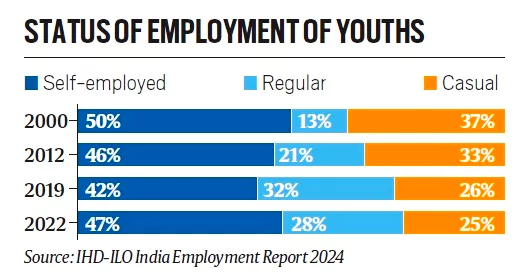
The India Employment Report 2024 recommends five key policy areas for youth in India,
About Institute of Human Development (IHD)
|
|---|
| Must Read | |
| NCERT Notes For UPSC | UPSC Daily Current Affairs |
| UPSC Blogs | UPSC Daily Editorials |
| Daily Current Affairs Quiz | Daily Main Answer Writing |
| UPSC Mains Previous Year Papers | UPSC Test Series 2024 |
Recently, The Supreme Court ruled that imposing a bail conditions that prevents a person from participating in political activities violates their fundamental rights under the Constitution.
Supreme Court Rulings on Bail Conditions of High Courts
|
|---|
| Must Read | |
| NCERT Notes For UPSC | UPSC Daily Current Affairs |
| UPSC Blogs | UPSC Daily Editorials |
| Daily Current Affairs Quiz | Daily Main Answer Writing |
| UPSC Mains Previous Year Papers | UPSC Test Series 2024 |
India is actively reducing black carbon emissions through the Pradhan Mantri Ujjwala Yojana (PMUY).
| Must Read | |
| NCERT Notes For UPSC | UPSC Daily Current Affairs |
| UPSC Blogs | UPSC Daily Editorials |
| Daily Current Affairs Quiz | Daily Main Answer Writing |
| UPSC Mains Previous Year Papers | UPSC Test Series 2024 |
According to the observations of the experts, fresh groundwater may be found deeper than 250 metres and, in some cases, the groundwater is saline in nature in Sundarbans.
About Sundarbans
Significance:
|
|---|
About Mangroves
|
|---|
| Must Read | |
| NCERT Notes For UPSC | UPSC Daily Current Affairs |
| UPSC Blogs | UPSC Daily Editorials |
| Daily Current Affairs Quiz | Daily Main Answer Writing |
| UPSC Mains Previous Year Papers | UPSC Test Series 2024 |
Recently, the Telecom Regulatory Authority of India (TRAI) has released recommendations on ‘Usage of Embedded SIM for M2M Communications (Machine-to-machine Communications)’.
Telecom Regulatory Authority of India
|
|---|
| Must Read | |
| NCERT Notes For UPSC | UPSC Daily Current Affairs |
| UPSC Blogs | UPSC Daily Editorials |
| Daily Current Affairs Quiz | Daily Main Answer Writing |
| UPSC Mains Previous Year Papers | UPSC Test Series 2024 |
According to a report by the UN’s International Organization for Migration (IOM), nearly 60 percent of migrant deaths were linked to drowning in the last decade.
Migrant
|
|---|
| Must Read | |
| NCERT Notes For UPSC | UPSC Daily Current Affairs |
| UPSC Blogs | UPSC Daily Editorials |
| Daily Current Affairs Quiz | Daily Main Answer Writing |
| UPSC Mains Previous Year Papers | UPSC Test Series 2024 |
Recently, RBI revealed in its data that India’s current account deficit (CAD) narrowed to $10.5 billion, or 1.2 % of gross domestic product (GDP), in the third quarter (October-December) of FY2024.
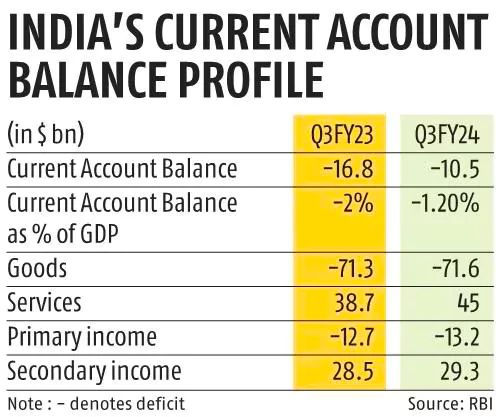
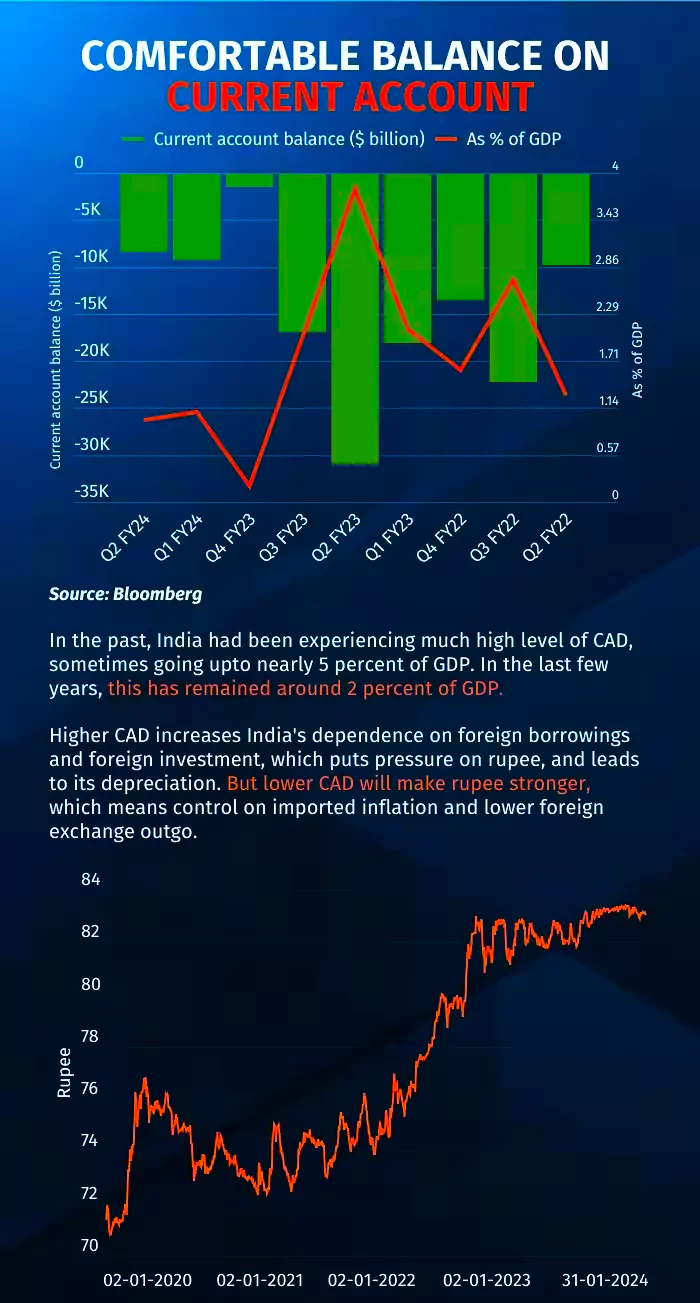 Foreign portfolio investment recorded a net inflow of $12 billion, higher than $4.6 billion during Q3 FY2023.
Foreign portfolio investment recorded a net inflow of $12 billion, higher than $4.6 billion during Q3 FY2023. 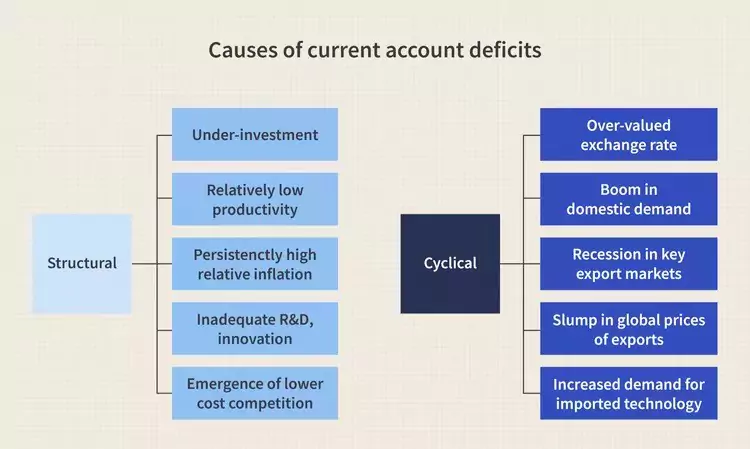
Following are the factors that can moderate India’s current account deficit:
| Current Account | Capital Account | |
| Definition | The current Account is the account that records the goods exports and imports, as well as trade in services and transfer payments. | Capital Account is the account that keeps track of Borrowing and Lending of Capital assets and non-financial assets between the countries. |
| Components | The current account is made up of visible trade( Goods), invisible trade (Services), transfer payments, net factor income, and remittances | The current account is made up of borrowings, lendings and investments. |
| Impact | The current account of a country keeps track of the country’s transactions with other countries. | The capital account of a country keeps track of the country’s investment and loans with other countries. |
| Must Read | |
| NCERT Notes For UPSC | UPSC Daily Current Affairs |
| UPSC Blogs | UPSC Daily Editorials |
| Daily Current Affairs Quiz | Daily Main Answer Writing |
| UPSC Mains Previous Year Papers | UPSC Test Series 2024 |
Recently, India has submitted an application to the International Seabed Authority (ISBA) seeking permission to explore the Afanasy Nikitin Seamount (AN Seamount) in the Indian Ocean.
Afanasy Nikitin Seamount
|
|---|
These rights are specific to areas part of the open Ocean.
Open Ocean
|
|---|
The United Nations Convention on the Law of the Sea (UNCLOS)
International Seabed Authority (ISA)
Commission on the Limits of the Continental Shelf
|
| Must Read | |
| NCERT Notes For UPSC | UPSC Daily Current Affairs |
| UPSC Blogs | UPSC Daily Editorials |
| Daily Current Affairs Quiz | Daily Main Answer Writing |
| UPSC Mains Previous Year Papers | UPSC Test Series 2024 |
AK Balan, a CPI(M) leader, has warned that the party might lose its iconic Hammer, Sickle, and Star symbol if it performs poorly in the upcoming 2024 Lok Sabha Elections.
About CPIM
|
A political party is recognized as a national party when it meets one of the following conditions mentioned in Election Symbols (Reservation and Allotment) Order, 1968:
| Must Read | |
| NCERT Notes For UPSC | UPSC Daily Current Affairs |
| UPSC Blogs | UPSC Daily Editorials |
| Daily Current Affairs Quiz | Daily Main Answer Writing |
| UPSC Mains Previous Year Papers | UPSC Test Series 2024 |
The External Affairs Minister (EAM) of India is on an official visit to the Philippines in the background of heightened tensions between the Philippines and Chinese naval forces.
| Relevancy for Prelims: South China Sea Dispute, UNITED NATIONS CONVENTION ON THE LAW OF THE SEA (UNCLOS), China’s Maritime Expansion, and India’s Response To China’s Naval Expansion.
Relevancy for Mains: South China Sea Dispute: Countries Involved, Causes and Solutions. |
|---|
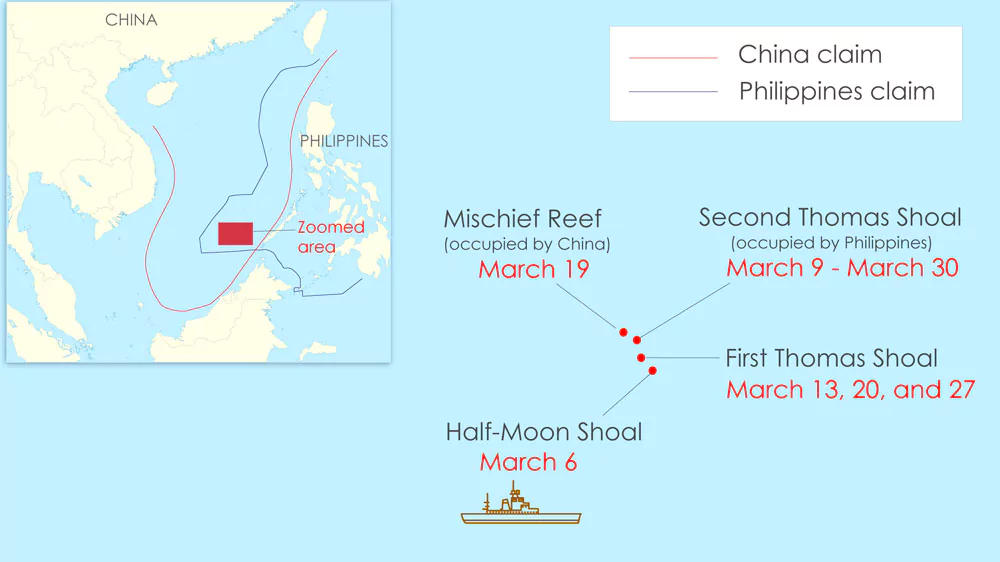
United Nations Convention on the Law of the Sea (UNCLOS)
|
|---|
Nine Dash Line:
|
|---|
About Scarborough Shoal:
|
|---|
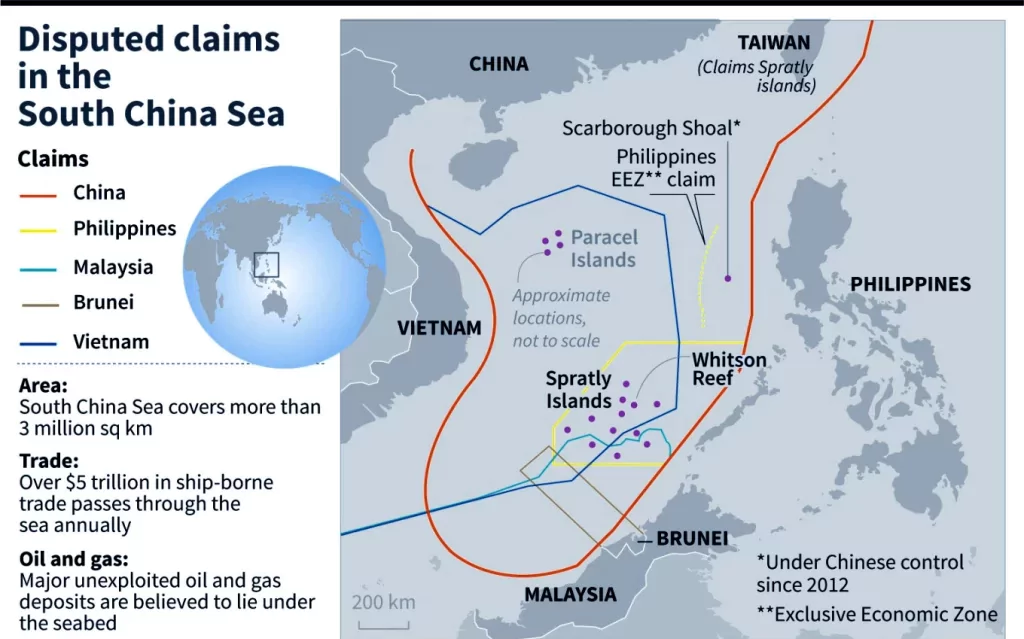 Vietnam: It claims sovereignty over the Paracel Islands and the Spratly Islands in the SCS. It also contests China’s claims and activities in the disputed waters.
Vietnam: It claims sovereignty over the Paracel Islands and the Spratly Islands in the SCS. It also contests China’s claims and activities in the disputed waters.
Recent Developments in South China Sea Region
|
|---|
India’s Stand on South China Sea Dispute
|
|---|
Measures by India:
|
|---|
| Prelims PYQ (2022):
With reference to the United National Convention on the Law of Sea, consider the following statements: 1. A coastal state has the right to establish the breadth of its territorial sea up to a limit not exceeding 12 nautical miles, measured from baseline determined in accordance with the convention. 2. Ships of all states, whether coastal or land-locked, enjoy the right of innocent passage through the territorial sea. 3. The Exclusive Economic Zone shall not extend beyond 200 nautical miles from the baseline from which the breadth of the territorial sea is measured. Which of the statements given above are correct? (a) 1 and 2 only (b) 2 and 3 only (c) 1 and 3 only (d) 1, 2 and 3 Ans: (d) |
|---|
| Must Read | |
| NCERT Notes For UPSC | UPSC Daily Current Affairs |
| UPSC Blogs | UPSC Daily Editorials |
| Daily Current Affairs Quiz | Daily Main Answer Writing |
| UPSC Mains Previous Year Papers | UPSC Test Series 2024 |
Union Cabinet Approves National Sports Policy 2025...
What are Altermagnets? A Breakthrough in Magnetism...
India’s 7-Point Strategy for Sustainable Gro...
Cabinet Approves Employment Linked Incentive Schem...
INS Udaygiri Delivered Under Project 17A to Indian...
SC Issues Implemented Reservation Roster for SC/ST...
<div class="new-fform">
</div>